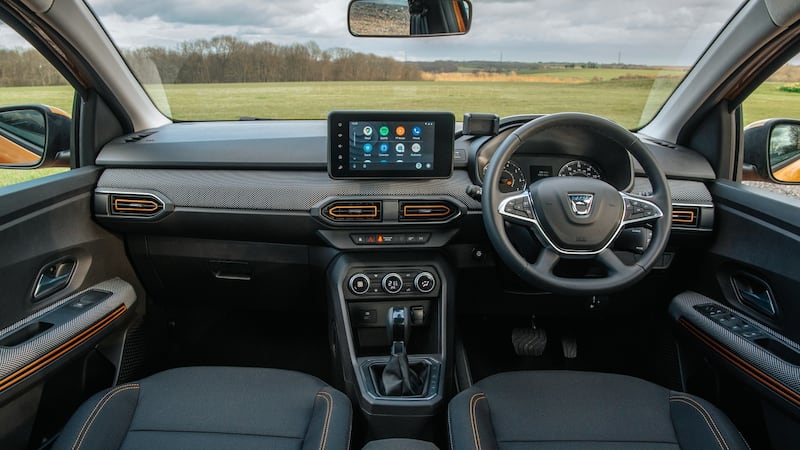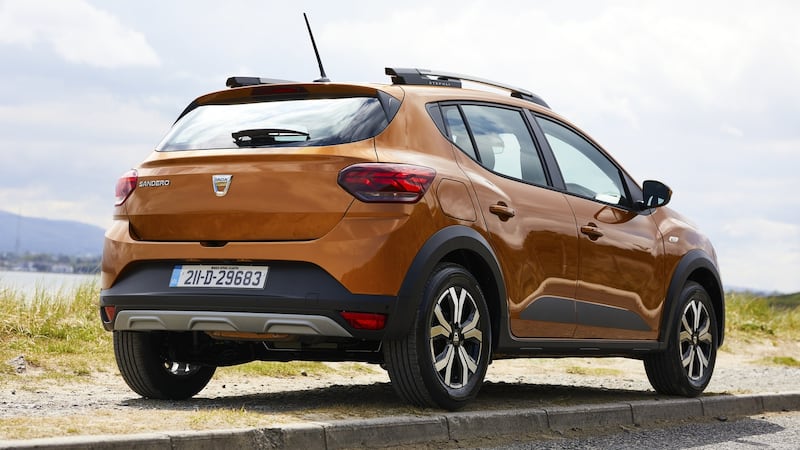Last year the average price paid for a new car in Ireland was €33,387. My only response to that is where the merry hell are you all getting that kind of cash from? New, used or fictional, I couldn't spend that much money on a car. Are journalists' wages that much lower than the national average?
Perhaps that's why I can so immediately see the appeal of the new Dacia Sandero Stepway. Clearly, in my rapidly advancing middle age, I've become my own father; a man who when presented with some shiny new piece of optional motoring equipment would always offer me the stout opinion that "it's just something else to go wrong".
In the previous Sandero Stepway, there really was nothing much to go wrong – aside from the possibility of losing a fingertip or two when looking for the bonnet release, so sharp and poorly finished were some of the plastics in the cabin. To be honest, I never much liked the old Stepway. There was little enough wrong with it, but being as it was about €2,000 more, model for model, than the basic Sandero hatchback, yet didn’t actually do anything especially different, it just seemed to fly in the face of Dacia’s value uber alles philosophy.
Dacia buyers entirely ignored me in that respect, and flocked to buy the Stepway, clearly figuring that its roof rails, plastic wheelarch extensions, and ever so slightly raised ride height were recompense enough for the extra outlay. Nowt so strange as folk.
Now we have the second generation Sandero Stepway, and the recipe is all but identical. Take the Sandero hatchback – much improved on its progenitor, with far better cabin quality, not to mention more space in the back seats – and sprinkle on some SUV fairy dust. The only significant mechanical difference between this orange-hued Stepway and a bog-basic Sandero hatch is that it rides some 40mm higher off the ground. I suppose that might offer some small advantage if you regularly go climbing over rocky, unmade roads, but for most of us it’s not really going to be much use beyond bragging rights at the local Dacia Owners’ Club meets.

Still, there’s undeniable appeal in the Stepway’s physiognomy. As with the regular Sandero, it looks far more handsome this time around, with more than a few hints of the VW Polo about its styling, and neat LED headlights adding some welcome aesthetic definition to the front end.
Inside, our top-spec Prestige model was positively dripping in extra equipment, including an eight-inch touchscreen with built-in sat-nav and Apple CarPlay, all-round electric windows, automatic air conditioning, a blind-spot monitor, cruise control, forward collision warning, tinted windows, and a reversing camera.
How much does that all cost? A relatively robust €20,390, but if that’s too much for your wallet (that’s my hand up) then a more basic Essential Stepway can be yours for €17,090, and you still get Bluetooth phone connection, auto headlights and wipers, cruise control, collision warning, and manual air conditioning.
You’ll also get the same engine, which is Renault’s 1.0-litre three-cylinder turbo petrol with 100hp. Actually, that’s not quite true, because it’s not just a petrol and it doesn’t have 100hp. In fact, if you’re running it on regular 95-octane unleaded, it has 90hp, and you’ll only unleash the full 100hp if you run it on LPG gas. Dacia includes a 50-litre LPG tank under the boot floor (goodbye spare wheel) and so you have two fuel sources, and a potential 1,000km-plus fuel range when both tanks are full.
LPG is less than half the price of petrol, assuming you can find any in your locale, so the benefits are obvious. Plus, it’s lower in CO2 for a given volume, and so Dacia claims that running on gas is a more cost-efficient way to trim your carbon footprint while it waits for the prices of batteries to come down to a more Dacia-friendly level.

So, you can save money, have more power, and cut your carbon, all at once? Well, it’s nice in theory but here is where my dad’s maxim about more things being more things to break comes in. I tried to run the Stepway as much as I could on LPG but each time I tried, at about 2,500rpm, the engine would start to cough and vibrate, and the engine check light would ominously shine. Hit the button to switch back to petrol and all would be fine, so it’s not like I was left stranded, but it’s still less than an impressive performance in the reliability stakes.
Equally, at various points in my test drive, the electric windows – all bar the driver’s – would mysteriously stop working no matter which position the window child lock was in. Again, it’s a relatively small niggle, but Dacia prides itself on its strong reliability performance (Dacia was beaten out only by Lexus in the most recent What Car? reliability survey) so such problems are not good for its image. Especially with my dad and me.
What's it like to drive? Not bad, actually. Underneath is basically the same chassis as that used by the current Renault Clio and Captur, so the Stepway is actually bang up to date in that regard. Being small and relatively light (just 1,100kg at the kerb) it was never going to be too awful, and yet it's better than it needs to be, with quick steering and solid stability. The extra 40mm in the springs seems to have helped the ride, too, which is well sorted, if not quite French-car pillowy. Cabin space is good, and the boot – 328-litres – is plenty big enough for most.
In fact, for the money Dacia’s asking, it seems hard to resist the Stepway’s charms. Or at least it would if it hadn’t proved my dad right. Maybe an older Sandero, with less to go wrong, would better please my bank balance.
Lowdown: Dacia Sandero Stepway 1.0 TCe BiFuel Prestige
Power: 1.0-litre three-cylinder turbo petrol & LPG engine putting out 100hp and 170Nm of torque with a six-speed manual transmission and front-wheel drive
CO2 emissions (annual motor tax): 130g/km (€200)
Fuel consumption: 5.8l/100km
0-100km/h: 11.9sec
Price: Sandero Stepway from €17,090; €20,390 as tested
Verdict: Reliability niggles detract from what's actually an impressive small hatch












